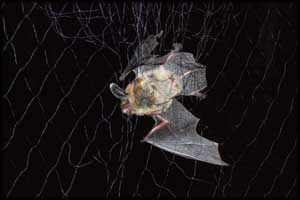 There are 4 species of long-eared myotis bats in B.C. that are all morphologically similar [Northern Long-eared, Western Long-eared, Keen’s myotis, and Fringed Bat]. Only one of these species [Northern Long-eared] is clearly distinct genetically. What distinguishes the other 3 species is not clear. Laura Friis, small mammal specialist for Ministry of Environment B.C., initiated a multi-year long-eared bat project to understand the differentiation between these species. B.C. biologists Cori Lausen, Dave Nagorsen, and Doug Burles are conducting this research.
There are 4 species of long-eared myotis bats in B.C. that are all morphologically similar [Northern Long-eared, Western Long-eared, Keen’s myotis, and Fringed Bat]. Only one of these species [Northern Long-eared] is clearly distinct genetically. What distinguishes the other 3 species is not clear. Laura Friis, small mammal specialist for Ministry of Environment B.C., initiated a multi-year long-eared bat project to understand the differentiation between these species. B.C. biologists Cori Lausen, Dave Nagorsen, and Doug Burles are conducting this research.
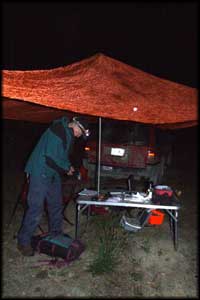 At left, Dave Nagorsen [Mammalia Consulting, B.C.] in the Skagit Valley, B.C. Dave and Cori captured bats here as part of the Ministry of Environment’s multiyear long-eared bat project. While heavy rain usually causes bats to head for home, they will continue to fly in light to moderate rain; in fact rain can improve mistnet capture success as bats head for tree cover to forage. Bat researchers head for tarp cover to measure and identify the bats.
At left, Dave Nagorsen [Mammalia Consulting, B.C.] in the Skagit Valley, B.C. Dave and Cori captured bats here as part of the Ministry of Environment’s multiyear long-eared bat project. While heavy rain usually causes bats to head for home, they will continue to fly in light to moderate rain; in fact rain can improve mistnet capture success as bats head for tree cover to forage. Bat researchers head for tarp cover to measure and identify the bats.
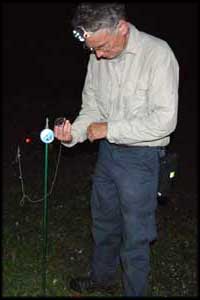 The photo at right shows Dave Nagorsen [Mammalia Consulting, B.C.] zip-lining a bat for acoustic sampling. Zip-lining involves tethering a bat to a horizontally strung fishing line using a light bungee cord. As the bat flies back and forth on the “clothes line” created between the two small green poles, we record its echolocation calls.
The photo at right shows Dave Nagorsen [Mammalia Consulting, B.C.] zip-lining a bat for acoustic sampling. Zip-lining involves tethering a bat to a horizontally strung fishing line using a light bungee cord. As the bat flies back and forth on the “clothes line” created between the two small green poles, we record its echolocation calls.
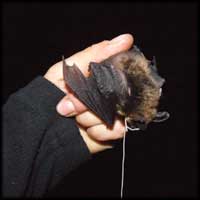 Part of understanding the biology and distribution of a bat species involves being able to recognize the pattern of their echolocation call.
Part of understanding the biology and distribution of a bat species involves being able to recognize the pattern of their echolocation call.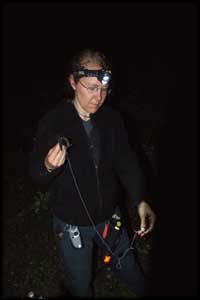 Ultrasound calls produced by bats vary from individual to individual, from species to species, and between different types of geography. Using a light elastic cord tied loosely around the back of the head of the bat [they really don’t have a neck!], a bat can be kept near a recording unit while it flies to ensure its acoustic signature is captured.
Ultrasound calls produced by bats vary from individual to individual, from species to species, and between different types of geography. Using a light elastic cord tied loosely around the back of the head of the bat [they really don’t have a neck!], a bat can be kept near a recording unit while it flies to ensure its acoustic signature is captured.
